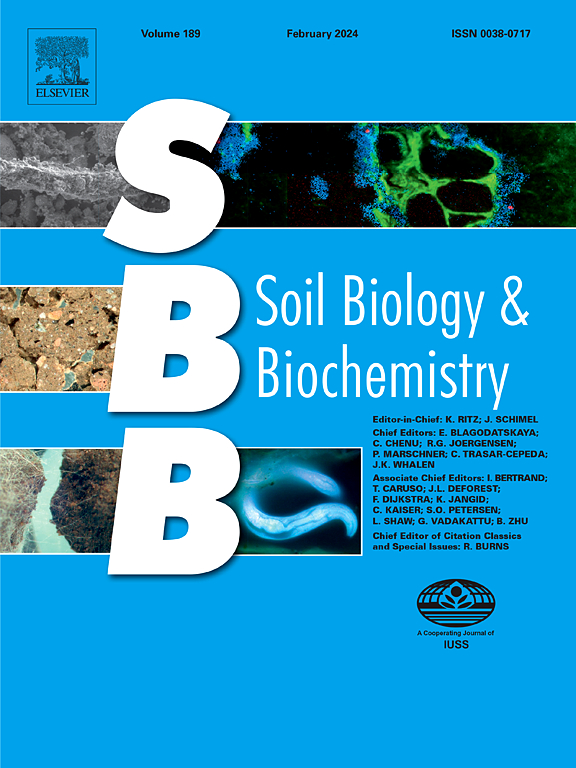使用氨基糖可以高估坏死块的形成微生物和植物细胞的死亡和裂解在土壤有机质形成中的作用
IF 9.8
1区 农林科学
Q1 SOIL SCIENCE
引用次数: 0
摘要
微生物和植物细胞死亡后土壤中发生的过程,以及细胞分子和细胞器在细胞裂解后的释放、吸附或降解,尽管它们对土壤有机质(SOM)的形成做出了贡献,但人们对这些过程知之甚少。在这篇综述中,我们讨论了关于植物和微生物细胞死亡和裂解后发生的过程的许多知识空白,并提出了未来研究的方向,以填补这些空白。我们特别强调,虽然使用表面反应性颗粒(如粘土矿物)的模型研究已经研究了重要生物分子(如蛋白质(包括酶)和DNA)的吸附和结合,但这些过程尚未对整个细胞器进行研究。这些可以通过微生物处理和随后在表面反应性土壤颗粒上的吸附或在土壤团聚体中作为微生物坏死团块的阻塞来保存其内容物,从而有助于SOM的形成。此外,活性酶可以在细胞死亡后持续存在,并在无序的细胞环境中促进坏死块的形成。然而,对细胞死亡后土壤中活性酶的持久性研究甚少。我们认为,高分辨率成像技术,例如纳米级二次离子质谱(NanoSIMS),可以通过在微观和纳米尺度上解决上述过程发生的土壤有机碳分布,帮助缩小相关研究空白。最后,微生物和植物源性SOM的量化仍然具有挑战性,因为最常用的微生物坏死块标记物(氨基糖)仅代表微生物细胞的一部分。过高估计的风险很高,我们建议结合氨基糖和细胞外DNA测定来确认坏死块的起源并降低这种风险。更好地了解植物和微生物细胞死亡和裂解后发生的过程,以及改进植物和微生物坏死块的量化,将为SOM的形成提供更详细的见解,并允许更有效地管理土壤有机碳。本文章由计算机程序翻译,如有差异,请以英文原文为准。
The role of death and lysis of microbial and plant cells in the formation of soil organic matter
Processes occurring in soil after microbial and plant cell death and release, adsorption, or degradation of cell molecules and organelles after cell lysis are poorly understood despite their contribution to the formation of soil organic matter (SOM). In this review, we discuss the many knowledge gaps with respect to processes occurring after death and lysis of plant and microbial cells and propose directions for future research to fill these gaps. We specifically highlight that while model studies using surface-reactive particles, such as clay minerals, have studied adsorption and binding of important biological molecules, such as proteins (including enzymes) and DNA, these processes have not been studied for entire cell organelles. These can contribute to the formation of SOM via preservation of their contents by microbial processing and subsequent adsorption on surface-reactive soil particles or occlusion in soil aggregates as microbial necromass. Moreover, active enzymes can persist after cell death and contribute to the formation of necromass in a disorganized cell environment. However, the persistence of active enzymes in soil after cell death is poorly studied. We argue that high resolution imaging techniques, for instance nano-scale secondary ion mass spectrometry (NanoSIMS), can aid in closing the related research gaps by resolving the distribution of soil organic carbon at the micro and nanometer scales, at which the above processes occur. Finally, the quantification of microbial- and plant-derived SOM is still challenging because the most commonly used marker for microbial necromass (amino sugars) only represents a part of microbial cells. The risk of overestimation is high, and we propose combining amino sugar and extracellular DNA determination to confirm necromass origin and reduce this risk. Better knowledge of the processes occurring after death and lysis of plant and microbial cells and improved quantification of plant and microbial necromass will provide more detailed insights into the formation of SOM and allow for a more efficient management of soil organic C.
求助全文
通过发布文献求助,成功后即可免费获取论文全文。
去求助
来源期刊

Soil Biology & Biochemistry
农林科学-土壤科学
CiteScore
16.90
自引率
9.30%
发文量
312
审稿时长
49 days
期刊介绍:
Soil Biology & Biochemistry publishes original research articles of international significance focusing on biological processes in soil and their applications to soil and environmental quality. Major topics include the ecology and biochemical processes of soil organisms, their effects on the environment, and interactions with plants. The journal also welcomes state-of-the-art reviews and discussions on contemporary research in soil biology and biochemistry.
 求助内容:
求助内容: 应助结果提醒方式:
应助结果提醒方式:


